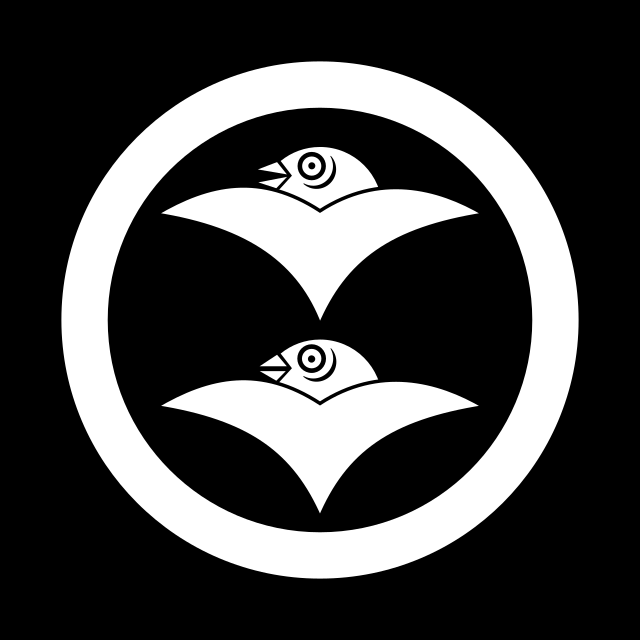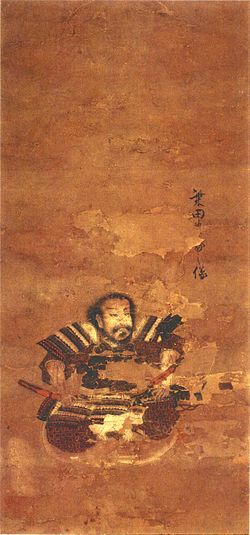Top Qs
Timeline
Chat
Perspective
Shibata Katsuie
Japanese samurai and military commander (1522–1583) From Wikipedia, the free encyclopedia
Remove ads
Shibata Katsuie (柴田 勝家, 1522 – June 14, 1583) or Gonroku (権六) was a Japanese samurai and military commander during the Sengoku period. He was retainer of Oda Nobuhide. He served Oda Nobunaga as one of his trusted generals, was severely wounded in the 1571 first siege of Nagashima, but then fought in the 1575 Battle of Nagashino and 1577 Battle of Tedorigawa.[1]
Remove ads

Remove ads
Early life
Summarize
Perspective

Katsuie was born in the village of Kamiyashiro (present-day Meitō-ku, Nagoya), a branch of the Shiba clan (who descended from the Ashikaga clan, and were the former suzerains of the Oda clan). Note the differences between Shibata (柴田), Shiba (斯波), and the Shibata clan of Echigo (新発田).
Katsuie was the retainer of Oda Nobuhide and later Oda Nobuyuki. In 1547, he fought at the Battle of Kanōguchi against the Saito clan and, in 1548, Katsuie took part in the second Battle of Azukizaka against Imagawa clan.
In 1556, when control of the Oda clan was contested, Katsuie initially supported his lord, Nobuyuki, against his elder brother Oda Nobunaga. Katsuie launched a coup d'état against Nobunaga. He was defeated at the Battle of Inō, and, in the aftermath, Nobunaga had his brother executed. But, impressed with the retainer's loyalty and bravery, Nobunaga spared Katsuie's life. Katsuie then pledged his services to Nobunaga, earning his praises.
In 1556, according to the records from the Tosho Gunkan, Sakai Tadatsugu defended Fukutani Castle, which was being besieged by 2,000 cavalry troops from the Oda Clan led by Shibata Katsuie. Tadatsugu managed to repel Katsuie's forces as he led a sallying force outside the castle and routed them.[2][3][unreliable source?][4][unreliable source?][5][unreliable source?][6]
Remove ads
Service under Nobunaga
Summarize
Perspective

Due to his identity, he don't have any important position when Battle of Okehazama and against Saitō clan.[7] But he ordered to be a Bugyō when 1565.
In late 1568, Katsuie pardoned by Nobunaga, along with Hosokawa Fujitaka, Hachiya Yoritaka, Mori Yoshinari and Sakai Masahisa attacked Iwanari Tomomichi at Shōryūji Castle.
In 1570, while the Oda–Tokugawa coalition fought at the Battle of Anegawa against the Asakura and Azai clans, Katsuie was at Chōkō-ji castle, under siege by 4,000 soldiers of the Rokkaku clan. Katsuie eventually won via an all-out attack, forcing the Rokkaku to retreat.[1]: 220 This action, along with a series of brilliant victories, gained him renown as the "Oni Shibata", or "Demon Shibata".
In 1571, he fought in the first Siege of Nagashima and was severely wounded.
In 1573, when Shogun Ashikaga Yoshiaki, who was protected by the Mori clan, built an anti-Nobunaga network, Katsuie fought against Yoshiaki's forces in various places including Omi Province and Settsu Province as a powerful military commander of the Oda army. Later, He took part in the Siege of Ichijodani Castle and also in the Second Siege of Nagashima right after that, but he pulled back again.
In 1574, he took part in the third Siege of Nagashima. He commanded the right wing among the three groups along with Sakuma Nobumori.
In 1575, he fought in the Battle of Nagashino against Takeda Katsuyori.[8] He and Hashiba Hideyoshi protected the left flank.
In 1576, after gaining control of Echizen, he took command of Kitanosho Castle (Hokujō) and was ordered to conquer the Hokuriku region.
In 1577, Nobunaga sent an army led by Shibata Katsuie and some of his most experienced generals to reinforce Shigetsura from Noto province against Uesugi Kenshin at the Battle of Tedorigawa.
In 1580, he led an army, which included his general Sakuma Morimasa in a fight against the Kaga Ikko-ikki at Kanazawa Gobo.[1]: 230
In 1581, after controlling Noto, he began a campaign against Etchū Province along with Maeda Toshiie, Sassa Narimasa and Fuwa Mitsuharu.
Death of Nobunaga
In 1582, he and Sassa Narimasa successfully laid siege to Uozu and Matsukura Castle.[1]: 231 In the meantime, Oda Nobunaga and his eldest son and heir, Nobutada, were killed in the Honnō-ji incident by the forces of his former retainer Akechi Mitsuhide.
Remove ads
Death
Summarize
Perspective
Later in 1582, after the death of Nobunaga, in a meeting at Kiyosu Castle to determine Nobunaga's successor, Katsuie initially supported the choice of Samboshi, Nobunaga's grandson.[9] but he later supported Oda Nobutaka, Nobunaga's third son, for whom Katsuie had performed the genpuku ritual. He then allied with Oda Nobutaka and Takigawa Kazumasu against Toyotomi Hideyoshi who was allied with Oda Nobukatsu. Tension quickly escalated between Hideyoshi and Katsuie, and the following year they clashed at the Battle of Shizugatake.[10]
Battle of Shizugatake
In 1583, Katsuie sent his nephew Sakuma Morimasa to besiege Takayama Ukon and Nakagawa Kiyohide at Shizugatake. Morimasa ignored Shibata's orders to withdraw to Ōiwa and was captured and beheaded by Toyotomi Hideyoshi's returning forces.[11] Katsuie was defeated and retreated back into Echizen, all the way to Kitanosho Castle, which was taken in 3 days.
During the siege, Katsuie implored his wife, Oichi, to take their daughters and leave, but she decided to stay and die with him, while letting their daughters escape. After setting fire to his castle, Katsuie committed seppuku.[12][13][1]: 234
His death poem was:
- 夏の夜の 夢路儚き 後の名を 雲井にあげよ 山不如
- Natsu no yo no
- yumeji hakanaki
- ato no na o
- kumoi ni ageyo
- yamahototogisu
"Fleeting dream paths, In the summer night! O bird of the mountain, Carry my name beyond the clouds."

Family
In popular culture
Shibata Katsuie is a playable character in Koei Tecmo's Samurai Warriors 2: Empires and all subsequent Samurai Warriors, the Warriors Orochi games, and Sengoku Basara 4. He appears in Nioh 2 and Fate/Grand Order as a side character.
See also
- People of the Sengoku period in popular culture § Shibata Katsuie
- The Kiyosu Conference (2013 film)
- Fukui Castle, residence of Katsuie
References
External links
Wikiwand - on
Seamless Wikipedia browsing. On steroids.
Remove ads

